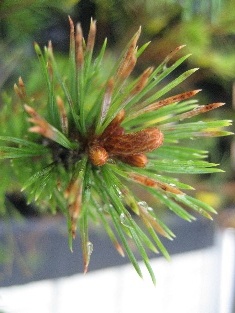 Trees have significant impacts on rural and urban landscapes and contribute to our heritage, ecosystems, rural economy and wellbeing. Trees have significant impacts on rural and urban landscapes and contribute to our heritage, ecosystems, rural economy and wellbeing.
The National Ecosystem Assessment highlighted the important contribution trees and forests make to society and the environment through the ecosystem services they provide and their direct economic and social amenity value. Trees can also help to mitigate climate change by capturing and storing carbon. Research into the preservation of the health of trees, woodlands and forests, and associated interactions with the environment, economy and society has the potential to be of great benefit. In the last few years, several new pests and pathogens have emerged as significant threats to the UK's woodlands, commercial forests and urban trees. The globalisation of trade, and associated changes in lifestyles and purchasing patterns, have led to a marked increase in the volume and diversity of plants and plant products entering the UK. This has increased the risk of importing pests or pathogens capable of causing serious damage to woodland flora or commercial tree crops. There have been many instances where outbreaks of new tree pests and diseases have been linked to the import of infected plants or plant products. In addition new pests and pathogens may be able to enter the UK without human mediation, through, for example, spores being blown on the wind or flying insect pests or vectors of pathogens reaching the UK from other countries. Predicted climate change effects, such as warmer winters or changes in seasonal rainfall and storm patterns, may also increase the risk of pest or pathogen establishment and spread. A consortium of funders from across disciplines and remits has established a joint strategic research initiative to bring together, and help develop, the widest possible research capacity and capability to address tree health in the UK. The initiative seeks to address the urgent need for innovative and cutting-edge interdisciplinary research to help ensure the future health and resilience of trees, woodlands and their associated ecosystems, including appreciation of their significance in the landscape, and of their wider cultural and social value. The initiative will address research challenges of increasing threats from pests and diseases, potentially exacerbated by a changing environment, society and economy. THAPBI has been developed over three phases: Phase 1 involved the development of new research consortia, phase 2, involved seven research projects that started in 2014, and phase 3 two projects that started in 2016. The overarching aim of this interdisciplinary initiative is to support the health and resilience of UK trees and woodlands, and of their associated biodiversity and ecosystems services. It will inform the development of methods for countering the threats from emerging pests and pathogens, and the evaluation of potential control, mitigation or adaptation strategies. The initiative aims to generate natural and social scientific knowledge to improve understanding of the environmental, economic and social impacts of changes in tree health. News| Recently Updated |
|---|
| types | blog |
|---|
| max | 5 |
|---|
| theme | concise |
|---|
|
| Lozenge |
|---|
| color | bronze |
|---|
| arrow | blue |
|---|
| icon | !book_open.png! |
|---|
| link | Biological control of insect pests - BIPESCO |
|---|
| width | auto |
|---|
| Biological control of insect pests - BIPESCO, led by Professor Tariq Butt, Swansea University |
| | Lozenge |
|---|
| arrow | blue |
|---|
| icon | !book_open.png! |
|---|
| link | Communicating tree health risks - UNPICK |
|---|
| width | auto |
|---|
| Communicating tree health risks - UNPICK, led by Dr Clive Potter, Imperial College London |
| | Lozenge |
|---|
| color | cyan |
|---|
| icon | !book_open.png! |
|---|
| link | Detection of pests and pathogens |
|---|
| width | auto |
|---|
| Detection of pests and pathogens, led by Dr Rick Mumford, the Food & Environment Research Agency (Fera) |
| | Lozenge |
|---|
| color | purple |
|---|
| icon | !book_open.png! |
|---|
| link | FOrest REsilience MOdelling Disease-FOREMOD |
|---|
| width | auto |
|---|
| FOrest REsilience MOdelling Disease-FOREMOD, led by Dr Adam Kleczkowski, University of Stirling |
| | Lozenge |
|---|
| color | blue |
|---|
| icon | !book_open.png! |
|---|
| link | Genomic resources in the genera Fraxinus |
|---|
| width | 100% |
|---|
| Genomic resources in the genera Fraxinus, led by Dr Richard Buggs, Queen Mary, University of London |
| | Lozenge |
|---|
| color | gold |
|---|
| icon | !book_open.png! |
|---|
| link | Population structure of ash dieback fungus |
|---|
| width | 100% |
|---|
| Population structure of ash dieback fungus, led by Professor James Brown, John Innes Centre |
| | Lozenge |
|---|
| arrow | blue |
|---|
| icon | !book_open.png! |
|---|
| link | Protecting Oak Ecosystems-PuRpOsE |
|---|
| width | 100% |
|---|
| Protecting Oak Ecosystems - PuRpOsE, led by Professor Robert Jackson, University of Reading |
| | Lozenge |
|---|
| color | green |
|---|
| arrow | blue |
|---|
| icon | !book_open.png! |
|---|
| link | Genomic resources in the genera Fraxinus |
|---|
| width | 100% |
|---|
| Global threats from Phytophthora spp - Phyto-threats, led by Dr Sarah Greene, Forest Research |
| | Lozenge |
|---|
| color | red |
|---|
| icon | !book_open.png! |
|---|
| link | Promoting resilience to pests and pathogens - PROTREE |
|---|
| width | 100% |
|---|
| Promoting resilience to pests and pathogens - PROTREE, led by Dr Stephen Cavers, Natural Environment Research Council, Centre for Ecology and Hydrology |
|
|